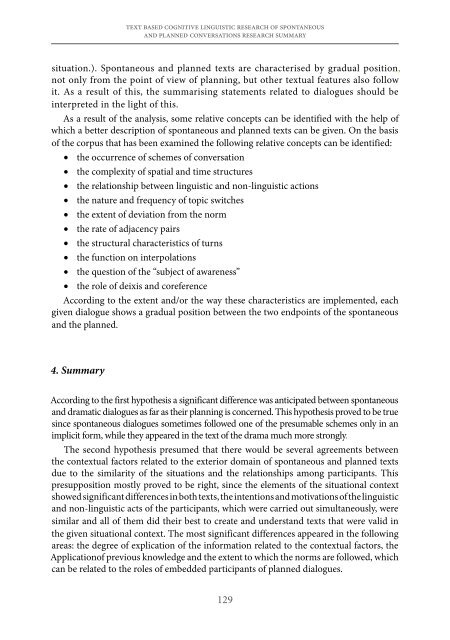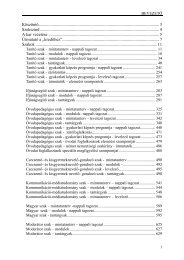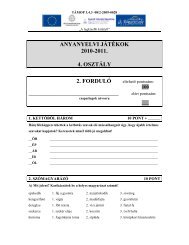ACTA SZEKSZARDIENSIUM - Pécsi Tudományegyetem Illyés Gyula ...
ACTA SZEKSZARDIENSIUM - Pécsi Tudományegyetem Illyés Gyula ...
ACTA SZEKSZARDIENSIUM - Pécsi Tudományegyetem Illyés Gyula ...
You also want an ePaper? Increase the reach of your titles
YUMPU automatically turns print PDFs into web optimized ePapers that Google loves.
text based cognitive linguistic research of spontaneous<br />
and planned conversations research summary<br />
situation.). Spontaneous and planned texts are characterised by gradual position,<br />
not only from the point of view of planning, but other textual features also follow<br />
it. As a result of this, the summarising statements related to dialogues should be<br />
interpreted in the light of this.<br />
As a result of the analysis, some relative concepts can be identified with the help of<br />
which a better description of spontaneous and planned texts can be given. On the basis<br />
of the corpus that has been examined the following relative concepts can be identified:<br />
• the occurrence of schemes of conversation<br />
• the complexity of spatial and time structures<br />
• the relationship between linguistic and non-linguistic actions<br />
• the nature and frequency of topic switches<br />
• the extent of deviation from the norm<br />
• the rate of adjacency pairs<br />
• the structural characteristics of turns<br />
• the function on interpolations<br />
• the question of the “subject of awareness”<br />
• the role of deixis and coreference<br />
According to the extent and/or the way these characteristics are implemented, each<br />
given dialogue shows a gradual position between the two endpoints of the spontaneous<br />
and the planned.<br />
4. Summary<br />
According to the first hypothesis a significant difference was anticipated between spontaneous<br />
and dramatic dialogues as far as their planning is concerned. This hypothesis proved to be true<br />
since spontaneous dialogues sometimes followed one of the presumable schemes only in an<br />
implicit form, while they appeared in the text of the drama much more strongly.<br />
The second hypothesis presumed that there would be several agreements between<br />
the contextual factors related to the exterior domain of spontaneous and planned texts<br />
due to the similarity of the situations and the relationships among participants. This<br />
presupposition mostly proved to be right, since the elements of the situational context<br />
showed significant differences in both texts, the intentions and motivations of the linguistic<br />
and non-linguistic acts of the participants, which were carried out simultaneously, were<br />
similar and all of them did their best to create and understand texts that were valid in<br />
the given situational context. The most significant differences appeared in the following<br />
areas: the degree of explication of the information related to the contextual factors, the<br />
Applicationof previous knowledge and the extent to which the norms are followed, which<br />
can be related to the roles of embedded participants of planned dialogues.<br />
129




